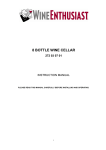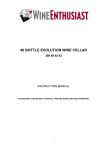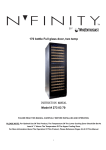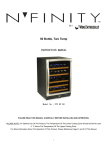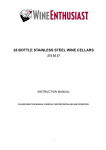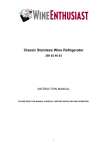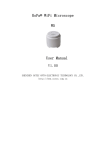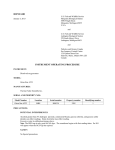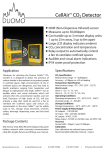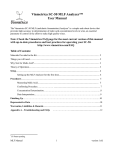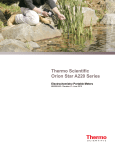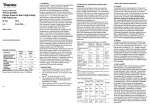Download Measuring the Dissolved Oxygen of Wine in the
Transcript
Water Analysis Instruments, Thermo Fisher Scientific Appl i cati o n No te 015 Measuring the Dissolved Oxygen of Wine in the Bottle Key Words Wine quality, dissolved oxygen, RDO sensor, portable meter, beverage testing. Goal The following application note describes how to reliably measure the oxygen content of wine directly in the bottle, using a Thermo Scientific™ Orion™ Rugged Dissolved Oxygen (RDO) Sensor with automatic temperature compensation and a Thermo Scientific™ Orion Star™ A223 RDO/DO portable meter. Introduction Equipment A bottle of wine’s oxygen content has a great effect on its quality, stability and longevity. This is why monitoring and controlling the oxygen incorporation at different stages of the wine-making and bottling process is becoming a growing concern for wineries. Although oxygen is a part of the wine’s natural aging process, adverse levels can cause discoloration to white wines and flavor degradation to both white and red varietals. To ensure the consumer is getting the highest quality product, measuring the concentration of molecular oxygen of wine after bottling is very important. • Orion Star A223 RDO/DO Portable Meter Kit – includes RDO optical DO sensor, portable meter armor, field case and USB computer cable (Cat. No. STARA2235) or By using a Thermo Scientific Orion RDO optical dissolved oxygen sensor and a Thermo Scientific Orion Star A223 RDO/DO portable meter, reliable oxygen measurements can be made directly in the bottles of wine. • Orion Star A223 RDO/DO Portable Meter (Cat. No. STARA2230) or equivalent Orion portable RDO meter • RDO Optical DO Sensor – includes calibration sleeve and stainless steel sensor guard (Cat. No. 087010MD) • Silicone tubing Solutions • Deionized water (DI) 2 Luminescence-Based Dissolved Oxygen Method The oxygen content of wine must be monitored throughout the wine-making process. Using the RDO sensor with built-in automatic temperature compensation and a portable meter, reliable measurements can be directly in the wine bottle. RDO Sensor Setup Refer to the RDO Optical Dissolved Oxygen Sensor User Guide for detailed assembly and preparation instructions for the RDO sensor. Place RDO sensor into the calibration sleeve. Remove the sponge from the bottom of the calibration sleeve. Moisten it with DI water, squeeze out excess water, and replace the sponge. Connect the RDO sensor to the 9-pin MiniDIN input on the meter. Once assembled, the RDO sensor can be used immediately. Meter Setup Turn the meter on. The meter should automatically detect the type of DO sensor and update the measure type to RDO. Access the setup menu and update the RDO/DO channel settings to the following, as needed: • Measure Mode: Auto • Measure Unit: mg/L • Resolution: 0.01 • Read Type: Auto Read • Baro Pressure: Auto • Salinity Correct: Manual (0.0) Update the instrument settings to the following, as needed: • Export Data: On • Data Log: On • Date / Time: Set current date & time Sensor Performance Checks A properly calibrated RDO sensor should read between 98 and 102 % saturation in the calibration sleeve. If not, recalibrate the sensor. The RDO sensor should stabilize during calibration within 2 minutes when working properly. Make sure to thoroughly rinse and blot dry the DO sensor after measuring samples and before placing into the calibration sleeve (see Comments section). Refer to the RDO sensor user manual if the sensor does not pass the performance checks. Sensor Rinsing, Soaking and Storage After each sample measurement, rinse the RDO sensor thoroughly with deionized water and blot the sensor dry with a lint-free cloth. For short term storage, overnight or between measurements, keep the RDO sensor in the calibration sleeve or a biochemical oxygen demand (BOD) bottle with water-saturated air. For long-term storage, keep the RDO sensor in the calibration sleeve. Sample Preparation and Preservation No sample preparation required. Dissolved oxygen can be measured directly in the wine bottle. Calibration If not already done, prepare the RDO according to the RDO Sensor Setup procedure. Perform a water-saturated air (Air) calibration with the RDO probe in the prepared calibration sleeve. A stable reading of 100.0 % saturation should be displayed within about two minutes. Analysis Slide a ring of silicon tubing over the RDO sensor, sliding it up the probe to just below the threads. For details see Notes below. Rinse the RDO sensor with deionized water and blot excess rinse water off with a lint-free cloth. Place the RDO sensor in the bottle. The silicone ring should make a seal with the bottle. Place the bottle on its side so the neck becomes flooded with wine, covering both the dissolved oxygen and temperature sensors on the RDO probe. Initiate a reading using the Auto Read measurement mode by pressing the measure key on the meter keypad. For best results, take a second reading to ensure the dissolved oxygen measurement is fully stabilized, as it may take the RDO sensor one to two minutes to fully stabilize in the wine sample. Use the second stable value for the oxygen content of the wine. Both readings will be saved in the meter data log. Comments It is important to thoroughly clean the RDO sensor after sample measurement. Rinse with deionized water and thoroughly blot all excess water with a lint free cloth several times before putting the sensor in the calibration sleeve. Rinsing following the completion of all sample measurements should take 5 to 10 minutes. The Orion meter data log collects up to 1000 measurement sets with time and date stamp and the non-volatile meter memory preserves data, even with loss of power. Download Orion Star Com software to facilitate the transfer of the data log from the meter to a computer at www.thermoscientific.com/OrionMeters. Use the Orion Star Com software to export data to a Microsoft® Excel® spreadsheet or as a comma separated value file (.csv) or print data to a network or local printer. Quality Control (QC) Recommended QC procedures may include: calibration, check of the thermistor (temperature sensor) response against a calibrated NIST-traceable thermometer, and measurement of a zero DO solution, such as 5% sodium sulfite. Notes • RDO sensors do not require stirring or a sample stream for accurate measurements. The speed, accuracy, and precision of the RDO sensor are equivalent or superior to the traditional polarographic sensor measurement. • Silicone tubing is necessary to make a seal so the bottle can be laid on its side, immersing the probe and temperature sensor in the sample while keeping all of the wine in and ambient oxygen out of the bottle. The RDO sensor and temperature sensor are not immersed in the sample if the bottle is sitting upright. Use a piece of soft silicone tubing with an inner diameter of 1/2 to 5/8 inch and outer diameter of 5/8 to 3/4 inch with a wall thickness of 1/8 inch. Cut a ring of tubing that is 1/4 to 1/2 inch wide. Before measuring the wine sample in the bottle, slide the ring onto the probe and push it up to just below the threads. • If readings are slow or inconsistent, ensure the temperature sensor is completely submerged in the sample. • If the temperature sensor is not in the sample, the DO readings will be incorrect. • The RDO cap must be replaced every 365 days. The remaining RDO cap life can be viewed in the RDO/DO channel setup menu. The meter will display an error message when the RDO cap needs to be replaced. • Keeping the calibration sleeve clean and free from water or sample droplets is essential to getting good calibration and read back values in water-saturated air. Rinse the RDO sensor thoroughly with deionized water and wipe excess water with a lint-free cloth prior to putting the sensor in the calibration sleeve. Results Dissolved Oxygen Readings in Wine Bottles Oxygen (mg/L) White Wine Red Wine RDO Polarographic RDO Polarographic Sample 1 0.35 0.17 0.80 0.64 Sample 2 0.46 0.32 1.61 2.01 Sample 3 0.34 0.26 1.39 1.04 Temperature (ºC) 21.5 21 21.3 21.1 2.5 Polarographic RDO Oxygen (mg/L) 2.0 1.5 1.0 0.5 0.0 Sample 1 Sample 2 White Wine Sample 3 Sample 1 Sample 2 Red Wine Sample 3 3 Summary Visit www.thermoscientific.com/water for additional information on Thermo Scientific Orion products, including laboratory and field meters, sensors and solutions for pH, ion concentration (ISE), conductivity and dissolved oxygen analysis plus spectrophotometry, colorimetry and turbidity products. To purchase an Orion Star A223 RDO/DO portable meter, Orion RDO sensor and other related products, please contact your local equipment distributor and reference the part numbers listed below. Product Description Part Number Thermo Scientific Orion Star A223 RDO/Dissolved Oxygen Portable Meter STARA2230 Thermo Scientific Orion Star A223 RDO/Dissolved Oxygen Portable Meter Kit with RDO Optical DO Sensor, Portable Meter Armor, Field Case and USB Computer Cable STARA2235 Thermo Scientific Orion Star A326 pH/RDO/DO Portable Meter Kit with ROSS Ultra Low Maintenance Gel pH/ATC Electrode, RDO Optical DO Sensor, Portable Meter Armor, Field Case, Calibration Solutions and USB Computer Cable STARA3265 Thermo Scientific Orion Star A329 pH/ISE/Conductivity/RDO/DO Portable Meter Kit with ROSS Ultra Low Maintenance Gel pH/ATC Electrode, Conductivity Sensor, RDO Optical DO Sensor, Portable Meter Armor, Field Case, Calibration Solutions and USB Computer Cable STARA3295 RDO Sensors Thermo Scientific Orion RDO Sensor with 3 Meter Cable 087010MD Calibration Sleeve for RDO Sensors 087003 Accessories Stainless Steel Protective Sensor Guard for RDO Sensors 087002 RS232 Computer Cable 1010053 Portable Meters thermoscientific.com/water © 2015 Thermo Fisher Scientific Inc. All rights reserved. Microsoft and Excel are trademarks of Microsoft Corporation. All other trademarks are the property of Thermo Fisher Scientific and its subsidiaries. Water Analysis Instruments North America Toll Free: 1-800-225-1480 Tel: 1-978-232-6000 [email protected] AN-DOWINEBOT-E 0215 RevA Netherlands Tel: (31) 020-4936270 [email protected] India Tel: (91) 22-4157-8800 [email protected] Japan Tel: (81) 045-453-9175 [email protected] China Tel: (86) 21-68654588 [email protected] Singapore Tel: (65) 6778-6876 [email protected] Australia Tel: (613) 9757-4300 in Australia (1300) 735-295 [email protected] Appl i cati o n No te 015 Using an Orion Star A223 RDO/DO portable meter with an RDO optical dissolved oxygen sensor enables wineries to continually produce high quality wines. Because the RDO sensor allows the wine to be measured directly in the bottle, dissolved oxygen measurements can be made with speed and accuracy. The speed, accuracy and precision of the RDO sensor is equivalent or superior to current DO measurement techniques.




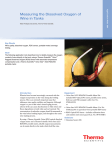
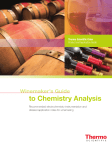
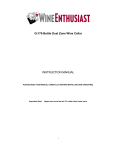
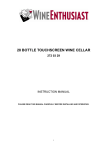
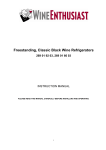
![Orion Dual Star Meter - Quick Start Guide [FR]](http://vs1.manualzilla.com/store/data/006397742_1-c5f0c81c8d03abe2c854cfa7d77645f9-150x150.png)
